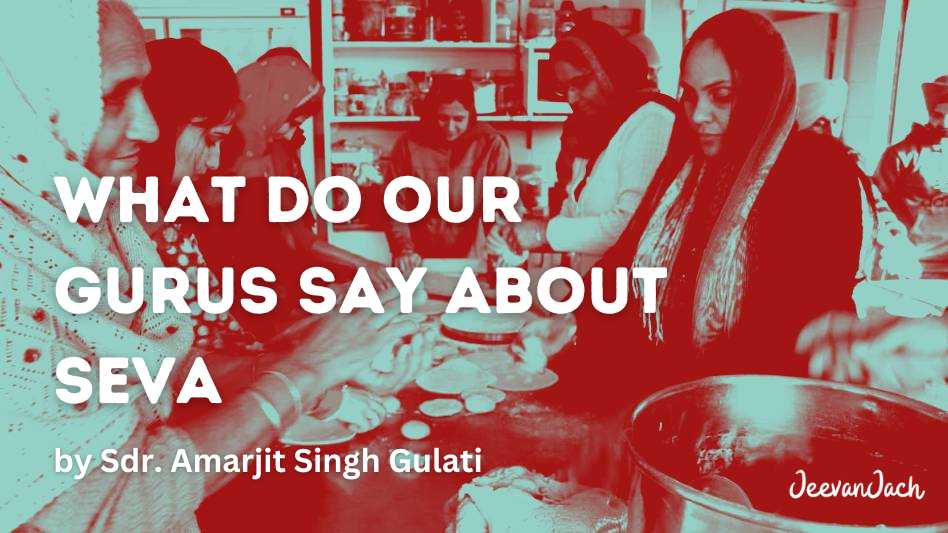
Recently, I visited a local gurdwara and saw a group of Punjabi families busy in the langar hall, cleaning and cutting vegetables, washing dishes and some were preparing food. However, what I also noticed is while they were doing Seva everyone was busy talking.
It made me think…
- Is it okay to talk while doing Seva?
- What is the true purpose of Seva ?
- How is Seva supposed to be done?
Hence, I began my research to find the answers from within SGGS.
Before that, I went on the Internet and discovered an online resource, stating that Seva in Sikhism means ‘selfless service’. It involves acting selflessly and helping others in a variety of ways, without any reward or personal gain. It is a way of life for many Sikhs and is part of their daily routine.
For me, this explanation was incomplete because I know, based on Gurmat, Seva is not just a physical selfless act to help others, it is more than that.
Different Forms of Seva
First, let’s examine the different forms of Seva. This is not an exhaustive list. Do feel free to share in the comments section below if I left out any other forms of Seva.
- Joriaa di seva (Wiping of footwear)
- Charu di seva (Sweeping the surroundings and inside the Gurdwara)
- Nishaan Sahib di seva (Cleaning the flag and its area)
- Langgar di seva (Making and serving food in the langar hall)
- Pandiaan di seva (Washing and stacking of dishes)
- Darbar di seva (Cleaning, vacuuming the darbar where SGGS is present)
- Shabad phet seva
- Gurdwara building fund seva
I’m sure most of us are quite familiar with the Seva listed above. Notice, when we talk about Seva, what comes to mind? Seva in the gurdwara. A physical activity that is carried out inside or in the surrounding compounds of a gurdwara. Towards the middle of this article, you’ll read a Gurmat concept of Seva.
Next question we need to ask ourselves is, why are we doing Seva? Are we doing it to appease Guru and God? Are we doing it because we want some material gain, better health, a new job, a career promotion or more business and money?
Did someone tell you doing Seva can help ease a dying or sick family members pain? Or perhaps you heard the local gurdwara Giani preach about Seva and told you how it can help you secure a seat in ‘heaven’?
Doing Seva helps but not in the ways described above. Moreover, you’ll soon realize, our Gurus have put a caveat, a condition to what They deem as Seva.
Whenever in doubt, always make it a point to refer to Gurbani enshrined within Sri Guru Granth Sahib. As Sikhs, we MUST benchmark our answers with what our Gurus viewpoints are, not just listening to some random dude. Then, there will be no doubt left.
Guru Amardas Ji (3rd Sikh Guru), says…
ਸਾ ਸੇਵਾ ਕੀਤੀ ਸਫਲ ਹੈ ਜਿਤੁ ਸਤਿਗੁਰ ਕਾ ਮਨੁ ਮੰਨੇ ॥
ਜਾ ਸਤਿਗੁਰ ਕਾ ਮਨੁ ਮੰਨਿਆ ਤਾ ਪਾਪ ਕਸੰਮਲ ਭੰਨੇ ॥
ਉਪਦੇਸੁ ਜਿ ਦਿਤਾ ਸਤਿਗੁਰੂ ਸੋ ਸੁਣਿਆ ਸਿਖੀ ਕੰਨੇ ॥
Sa Seva Kiti Safal Hai Jit Satgur Ka Man Maney ||
Ja Satguru Ka Man Maneya Ta Paap Kasamal Paney ||
Updesh Je Dita Satguru So Suneya Sikhi Kaney || (SGGS Mehl 3, 314)
Meaning,
One is considered to be doing Seva IF that Seva is in accordance and in acceptance of the teachings of the Guru (instructions contained within Sri Guru Granth Sahib -SGGS). When this condition is met ONLY then the Seva done is considered acceptable. This is the instructions (Updesh) given by the Guru and we are to listen and adhere to it attentively (So Suneya Sikhi Kaney).
In the Shabad above, it is clear what our Gurus consider acceptable Seva.
Goal of Seva
IF Seva done has to be followed by listening and adhering to the instructions of the Guru (as contained within SGGS), then the purpose of doing Seva would be to eliminate ones ego, evil thoughts, bad intentions, unwanted behavior and bad character and eventually adopt Godly virtues.
The “Updesh” instruction given by the Guru, which is to live a life free of vice, IF this were to be the focal point when carrying out the Seva, I doubt one would do much talking or gossiping while carrying out the seva.
Neither the Creator nor any of our Gurus need to be made happy by our Seva. Neither is there a ‘reward system’ of doing selfless service too regardless of what the Giani has preached as the reward concept – do this and you’ll get that, do that and you’ll get this – is NOT a Gurmat concept. Period!
Some religions may preach such concepts, such as doing Seva will ensure ones place in heaven or doing Seva can help one become more successful in business etc. These are ideas conjured by the pujaris (Hindu priests) back even (and probably even today) to instill fear and a false sense of loyalty and devotion. These are snatan (Brahmanical) ideology NOT inlne with Sikhi Gurmat concept.
Doing Seva Won’t Make My Guru Happy?
What we need to understand is, the Seva we do is NOT for making God or Guru happy.
Neither it is done to ask for favors or any rewards. It is supposed to be a sign of our love. Our feeling of thankfulness, gratitude and gratefulness towards our Guru for giving us the chance to be considered worthy of the advice or instructions (updesh).
There is NO point in doing Seva if one is not willing to listen to the instructions of the Guru or make any effort in changing ones mind or attitude.
The ego within has to be subdued and eliminated completely, only then the Seva done is considered fruitful. – Guru Amardas Ji
Seva Everywhere, At All Times
If this is the essence of what Seva is, then there is more to Seva. Seva cannot be just considered being done in a gurdwara.
Guru Arjan Dev Ji (5th Sikh Guru) says…
ਗੁਰ ਕੀ ਸੇਵਾ ਕਰਹੁ ਦਿਨੁ ਰਾਤਿ ॥
ਸੂਖ ਸਹਜ ਮਨਿ ਆਵੈ ਸਾਂਤਿ ॥੩॥
Gur Ki Sewa Karoh Din Raat ||
Sukh Sehaj Man Aavey Shaant ||3|| (SGGS Mehla 5, 741)
Meaning,
Living a virtuous life according to the teachings of the Guru (Gur Ki Seva) is to be done at all times – day and night (Karoh Din Raat). The outcome of such Seva is one will attain bliss, contentment and mind’s peace (fruits of Seva).
Take for example, Guru Angad Dev ji (Bhai Lehna), before He became Guru, he did a lot of Seva. He did not just do the Seva, he also listened to Guru Nanak’s instructions attentively AND applied the teachings in His own life.
Our Gurus mastered the art of transforming the mind, eliminating ego within and they never had any desires to receive any kind of reward in return. This is also called ‘Nishkaam Seva’. Service without any desire or wants. It’s a state of mind. Are we doing Seva in this state of mind?
On the other hand, when we see Guru Nanak’s disowned son – Sri Chand, refusing to listen to Guru Nanak’s instructions, teachings and advise, hence he lost the chance of becoming a Sikh or even to be appointed the next Guru of the Sikhs, which he yearned so badly.
In another place, Guru Ramdas Ji (4th Sikh Guru) says…
ਕੋਈ ਪੁਤੁ ਸਿਖੁ ਸੇਵਾ ਕਰੇ ਸਤਿਗੁਰੂ ਕੀ ਤਿਸੁ ਕਾਰਜ ਸਭਿ ਸਵਾਰੇ ॥
Koi Put Sikh Seva Karey Satguru Ki Tis Karaj Sabh Svarey || (SGGS Mehla 4, 307)
Meaning,
If a Sikh who does Seva for the Guru (by listening to the teachings and applying in ones life), then all his affairs are fulfilled.
“Koi Put Sikh” here simply means a Sikh who lives his life in accordance to the teachings of the Guru is considered by the Guru as his own child. Such a Sikh is indeed rare, because one has to constantly be aware of the Guru’s instructions and work on his/her mind, eliminating vices and adopting Godly virtues.
Guru says “Tis Karaj Sabh Svarey” meaning, the affairs of such a Sikh is fulfilled.
NOTE: The verse translation done by Sant Singh Khalsa MD therefore is misleading as it does not paint a clear picture and is merely a word level translation in English.
Here’s what MD translated…
If any son or Sikh serves the True Guru, then all of his affairs will be resolved.
Firstly, Guru is not referring to two different people here (son or Sikh). The translator has failed to understand the meaning of “Koi Put Sikh” and “Karaj Swarey” as part of a bigger context of the Shabad.
Just reading that one line (without seeing the whole Gurmat perspective) one may wrongly conclude Guru is saying, “Serve me and I shall resolve all your affairs”. What is considered as “Serve me”? How does one serve Guru?
Meaning of ‘Serve The Guru’
When our Gurus were in the physical human form, Sikhs made attempts to “serve” the Guru by way of preparing meals for Him, washing His clothes, fanning Him and the sangat during congregations, etc.
BUT today, our Guru is in the form of a compilation of Shabads, in the form of a scripture (SGGS) bonded in a book form. How can we possibly serve the Guru in the same way as we did when He was in the human form?
Logically speaking, how can Guru Granth Sahib Ji eat meals that we prepare or even take baths and wear clothes that we’ve washed and ironed? Yet, some Sikhs will argue, saying that this is exactly what we are supposed to do. Why? Because that’s how its been done for ages.
I’ve personally seen some gurdwaras, preparing langar and then setting aside a plate of all the dishes and leaving it under the Palki (altar where SGGS is present), perhaps hoping that Guru Granth Sahib would eat the meal?
Many Sikhs today are deluded and go about spending extravagantly on expensive Rumaleys (cloth coverings) to be placed upon Guru Granth Sahib or even preparing expensive langars, and paying for Akhand Paths, perhaps thinking that this is what Guru meant when he said Koi Put Sikh Seva Karey Satguru Ki?
So, what is Satguru Ki Seva then? Let’s seek the answer from within Guru Granth Sahib.
Guru Nanak Dev Ji in Raag Gauri says…
ਗੁਰ ਕੀ ਸੇਵਾ ਸਬਦੁ ਵੀਚਾਰੁ ॥
ਹਉਮੈ ਮਾਰੇ ਕਰਣੀ ਸਾਰੁ ॥੭॥
Gur Ki Seva Shabad Vichaar ||
Haumai Marey Karni Saar ||7|| (SGGS Mehla 1, 223)
Meaning,
Seva for the Guru equates to contemplating and reflecting upon the Shabad (Shabad Vichaar). By eradicating ego (Haumai Marey) one is able to live a virtuous life (Karni Saar).
In another stanza Guru Amardas Ji says…
ਗੁਰਮੁਖਿ ਭਗਤਿ ਅੰਤਰਿ ਪ੍ਰੀਤਿ ਪਿਆਰੁ ॥
ਗੁਰ ਕਾ ਸਬਦੁ ਸਹਜਿ ਵੀਚਾਰੁ ॥
Gurmukh Bhagat Antar Preet Pyar||
Gur Ka Shabad Sehaj Vichaar|| (SGGS Mehla 3, 364)
Meaning,
A Sikh who considers himself as a devotee is considered to have utmost love and devotion WHEN he contemplates upon the Shabad and reaches the state of Sehaj (contentment, egoless, virtuous living).
Ego and Pride
It takes great effort for one to eliminate ego.
It’s quite common to see when one does Seva without truly understanding this Gurmat concept, that they walk and talk in ego. This can include gurdwara sewadars, management committee, members of the sangat, people who are into humanitarian aids, etc. Many, I’m not saying all, don’t even realize that they’ve become victims of ego.
Some mistake it as pride, but there is a difference between ego and pride. One who is proud, accepts that his achievements are not all his own doing.
But one with ego brags about his achievements and dislikes giving credit to others who may have helped him/her achieve. They like telling everyone how ‘I ’ did it, what ‘I’ did and how ‘I’ achieved it all on ’My’ own.
Truth is, no one achieves anything on their own. We all rely upon one another.
Seeds rely opon the soil, sunshine and water to transform into plants. Animals and humans rely upon oxygen, food, water and shelter. Students rely upon their teachers for a wholesome education. Sikhs rely upon Guru Granth Sahib’s teachings to learn and live a spiritual life. We all rely upon one another, so why the ego?
Seva For The Creation
When one has elevated ones consciousness with the help of Sacha Gyan – Shabad Guru, one will not see others indifferently.
Then there is Seva towards animals, Seva towards nature, Seva towards other human beings, etc. All this is considered Seva too and can only be done without ego and any discrimination of social status, cast or creed.
This is the kind of Seva our Gurus are talking about in Gurbani. They’ve lived by it and taught Sikhs to do the same. Can you imagine Guru Nanak being present physically in our langar halls today, I would imagine there would be ‘pin-drop’ silence.
In Conclusion
Carry on doing the Seva as you’ve always enjoyed doing BUT from here on, think of what our Gurus have said about “Gur Ki Seva Shabad Vichaar”.
The highest form of Seva according to Guru is still contemplation and applying the teachings of Guru Granth Sahib in ones life. We need to transform our behavior, character and our minds to eliminate ego and adopt virtues for a better spiritual living.
Don’t go bargaining with the Guru. It makes NO difference to Guru if you were to do Seva or not. Seva done with the ‘right’ mindset and attitude matters. Yes, that also means we’re not supposed to talk or gossip during Seva.
When it comes to eliminating ego, here’s what Guru Angad Dev Ji (2nd Sikh Guru) says…
ਹਉਮੈ ਦੀਰਘ ਰੋਗੁ ਹੈ ਦਾਰੂ ਭੀ ਇਸੁ ਮਾਹਿ ॥
ਕਿਰਪਾ ਕਰੇ ਜੇ ਆਪਣੀ ਤਾ ਗੁਰ ਕਾ ਸਬਦੁ ਕਮਾਹਿ ॥
ਨਾਨਕੁ ਕਹੈ ਸੁਣਹੁ ਜਨਹੁ ਇਤੁ ਸੰਜਮਿ ਦੁਖ ਜਾਹਿ ॥੨॥
Haumai Deerag Rog Hai Daru Bhi Es Mahey||
Kirpa Karey Je Aapni Ta Gur Ka Shabad Kemahey||
Nanak Kehai Sunoh Janoh Eit Sanjam Dukh Jahey ||2|| (SGGS Mehla 2, 466)
Meaning,
Ego (Haumai) is the most dangerous disease of the mind. However, there is a cure. With the blessings of the Guru, one is able to attain the knowledge to subdue ego, hence ones mind is prepared to absorb and practice the teachings of the Guru (Shabad Kemahey). Guru Sahib says, listen! my beloved ones, this is the way, this is the method, to attain a life free of pain, misery and sorrow.
Image courtesy of RNZ



